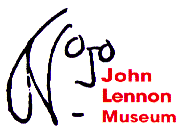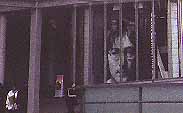
A trip out to Saitama Super Arena is a visit to the New
Japan: clean, antiseptic shades of gray, "steel and
glass." The weather synchronized the day I went, chilly
white sky with that pre-snow feeling. To get there from
Tokyo buy a ¥380 ticket at a machine and ride the
JR Keihin-Tohoku line north out to one stop before Omiya.
(The latter is identified by simple, easy kanji,
unlike the former.) This is the line which parallels the
Yamanote along its eastern side, or you can pick it up in
Akabane by taking the Saikyo line north out of western
Yamanote stations like Ikebukuro (as I did).

I suppose when there's an event at the arena mobs of people
could make finding the museum difficult, but otherwise you
just follow the crowd and you'll see the big two-story
head-shot of John (click to zoom). ¥1500 to get in, and
you're made to wait until a group forms, then led into a
small cinema for the introductory film, which begins with
Yoko's greeting (this is, after all, her show). Then, three
zones downstairs, four or five up (windows only on the upper
level):
- The early years, wartime, featured artifact: a comic book
he drew (I was reminded of R. Crumb's childhood output).
- Discovery of rock&roll, Quarrymen history, and a
banjo. (Several guitars are displayed throughout, I suppose
they were his, but this wasn't made clear by the limited
English captions.)
- Beatle room. Artifacts included his Sgt Pepper suit and the
passport he'd used touring, opened to the 1961 photo. This zone
ended with stuff from the "How I Won the War" movie.
- Meeting Yoko Ono, all about Yoko, reproductions of her art work.
- John & Yoko: Bag In, Bed In, Give Peace a Chance.
- Early 70s in New York City: concert videos, the "Lost Weekend."
- Domestic life, summers in Karuizawa, and then "Double
Fantasy." Artifacts included a black 'dragon' guitar and
unlike all the others, out in the open,
the white Steinway piano.
- Finally, a couple of spaces for contemplation. One has glass
panels inscribed with his quotes and lyrics, English on one side,
Japanese on the other, with clear plastic chairs where one can
sit and ponder. The other has counters with paper forms the visitor's
invited to fill out (Name, Age, Sex, Thoughts) facing nine
portraits of John through the ages, each with a little bin:
place your contribution at the photo you like best.
Then it's back downstairs to -- the Gift Shop! Breezing past
it on my way in I was excited, saw piles of headgear among the
inevitable T-shirts. It's time to replace my "Paul's Grandfather"
flat cap, the one I got in Slovenia's getting worn, and a "Hard
Day's Night" John cap could be viable. Alas, only floppy
Gilligan-style fisherman hats and baseball caps are available,
like the shirts all embroidered with the museum logo (in English
only*). I considered buying
a souvenir postcard or two but since their price was double the
going picture-postcard rate I passed. You can also stock up on
those ¥3000 CDs if you like, all John's records and the
Beatles' latest are there; as are many books, old &
new; plus replicas of his spectacles.
The visit wasn't particularly transcendent or joyful,
in fact it bummed me out -- brought back to mind the
tragedy of his murder. But a saving grace was, as I
was leaving I discovered my hat had gone missing -- an
inquiry at the information desk resulted in its return
(I'd dropped it in the theater). Had to fill in my name
& address on a form to get it back, however.
* Why do the Japanese fail to understand the desirable hipness
of kanji? It's the same with English, they plaster words all
over because they're exotic, shouldn't be difficult to
extrapolate that the foreign visitor wants the same thing.
Very difficult to locate souvenirs like that, however -- my
T-shirt with the characters that say "Kyoto" is a rare
find. One that says the same think in romanji,
however -- no problem.
|


